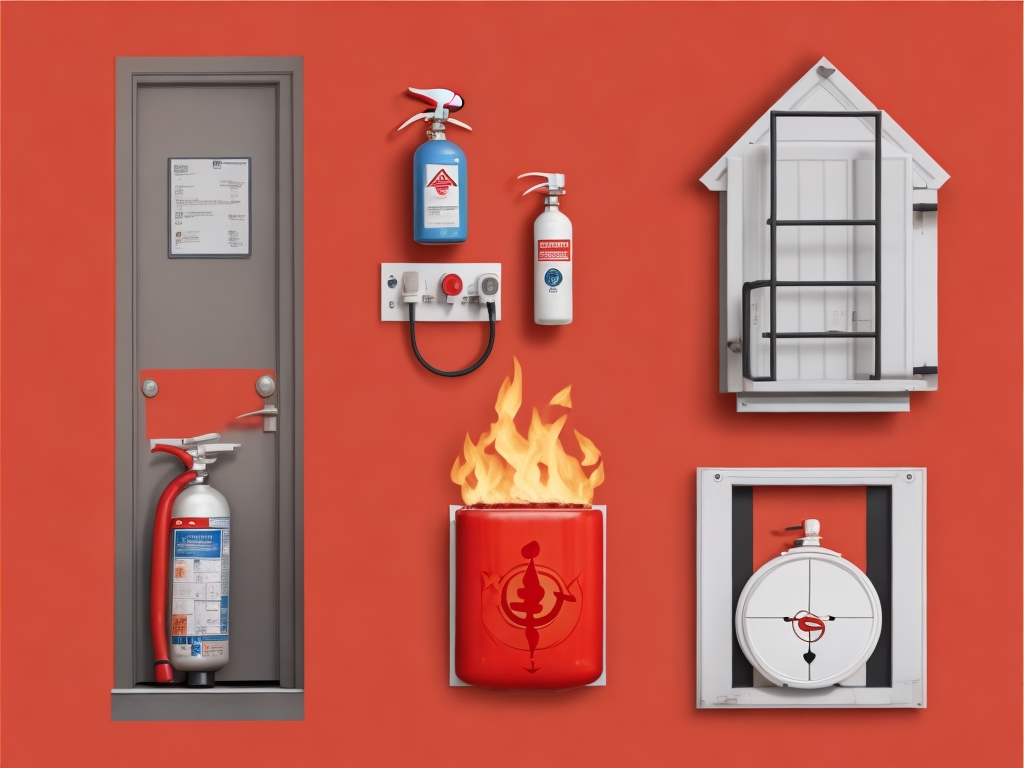What Are the Five Recommendations for Ensuring Fire Safety?
Don’t underestimate the importance of fire safety!
In this article, you’ll discover five key recommendations to ensure your safety.
Read more about the five fire safety tips→
We’ll guide you through
- regular inspections
- training procedures
- emergency exits
- handling flammable materials
- maintaining fire alarms
By the end, you’ll have a solid understanding of how to protect yourself and your property.
Let’s dive into these life-saving tips!
Understanding the Basics of Fire Safety
You’re on the right path to understanding the basics of fire safety. It’s crucial that you’re familiar with these principles to protect yourself and others.
First, you need to install smoke detectors in your house. They’re your first line of defense and provide early warning.
Second, you mustn’t overload electrical outlets; it’s a common cause of fire outbreaks.
Third, keep items that can catch fire away from your stove. It’s easy to forget, but it’s an important step.
Fourth, always have a fire extinguisher handy.
Finally, ensure you’ve planned and practiced a fire escape route with everyone in your household.
You’re doing great, and with these steps, you’re making your home a safer place.
First Recommendation: Regular Inspection of Fire Safety Equipment
It’s pivotal that you regularly inspect your fire safety equipment, and this includes everything from smoke detectors to fire extinguishers. This isn’t an optional task but a requirement to ensure you’re prepared in case of a fire emergency.
To make it more manageable, consider the following steps:
- Weekly Checks: Make it a habit to check your fire safety equipment every week. You’re looking for any signs of wear or damage.
- Monthly Inspections: Take a deeper look into your equipment every month. Test your smoke detectors and check the pressure on your fire extinguishers.
- Professional Inspections: Once a year, have a professional inspection. They can spot issues you might miss.
- Replacement: Don’t hesitate to replace any equipment that’s not functioning properly. Better safe than sorry.
Second Recommendation: Adequate Training in Fire Safety Procedures
In addition to inspecting your fire safety equipment, you’ll need to invest time in learning about and practicing fire safety procedures. It’s vital that you’re familiar with the basics such as stop, drop, and roll, and the correct way to use a fire extinguisher. You should also know the quickest and safest routes out of your building in case of a fire.
Training isn’t just about knowing what to do; it’s also about being able to react quickly and effectively in an emergency. Regular drills will help you to become comfortable with these procedures, so they become second nature. Don’t overlook the importance of this step in your fire safety plan. It could save your life one day.
Third Recommendation: Effective Emergency Exit Strategies
Following adequate training, you’ll need to focus on implementing effective emergency exit strategies, an essential aspect of fire safety. Don’t underestimate the importance of a well-planned escape route. It’s an integral part of fire safety that can save lives in a crisis.
Consider these key factors:
- Always have at least two exit routes from each room. You never know where a fire might start, blocking your primary route.
- Keep exit routes clear of clutter. It’s easy to trip or get stuck when you’re panicked and visibility is low.
- Regularly review and practice your escape plan. In an emergency, you won’t have time to think; it’s all about reaction.
- Install appropriate signage for exits. This can guide people who aren’t familiar with the layout of your property.
Fourth Recommendation: Safe Handling and Storage of Flammable Materials
While you’re taking care of exit strategies, don’t forget that safe handling and storage of flammable materials is another crucial step you’ll need to tackle. It’s not just about keeping these materials away from heat sources. It’s also about making sure they’re stored in approved containers and locations. You should also ensure that your staff knows how to handle them correctly.
Remember, accidents can happen, but they’re less likely if you’re prepared. So, train your team on the right procedures, and make sure they’re following them.
It’s also a good idea to have a professional inspect your facilities regularly. Don’t just assume you’re doing everything right. It’s always better to be safe than sorry.
Fifth Recommendation: Installation and Maintenance of Fire Alarms
You’re on the right track with handling flammable materials, but don’t overlook the importance of installing and maintaining fire alarms in your facility. These devices are your first line of defense against potential disasters. They’re critical for early detection of fires, giving everyone enough time to evacuate safely.
Here are some practical tips to ensure your fire alarms are always in top shape:
- Always test your alarms regularly. You can’t afford to have them malfunction when you need them most.
- Replace batteries annually, or as soon as you hear a low battery alert.
- Schedule professional inspections at least once a year.
- Never ignore or disable the alarms, even if they’re causing temporary inconvenience.
The Impact of Implementing Fire Safety Recommendations
By implementing these fire safety recommendations, you’re not only safeguarding your facility but also reducing the risk of devastating losses.
Imagine a fire breaking out and you’re unprepared. The damage could be catastrophic, affecting your business, employees, and potentially your entire livelihood.
Now consider the alternative. You’ve taken the time to install fire alarms, you’ve mapped out escape routes and trained your staff. Not only are you in a better position to prevent a fire, but should one occur, you’re ready.
This could mean a quicker recovery, less damage, and most importantly, safer employees. Prevention is key, and you’re taking control by being proactive about fire safety.
Your business, staff and peace of mind are worth it.
Conclusion
To ensure fire safety, you’ve got to pay attention to these five recommendations.
Regularly inspect your fire safety equipment and train everyone on fire safety procedures.
You’ll need effective emergency exit strategies and safe handling of flammable materials.
Finally, don’t forget to install and maintain fire alarms.
By following these steps, you’ll significantly reduce the risk of fire, protecting both your property and the people within it.
Source of information: https://secure-house.co.uk





